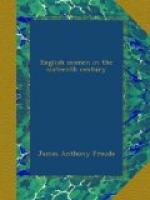Elizabeth’s death. It had been necessary,
however, to ascertain in some way whether her protestations
were sincere. A secret watch had been kept over
her correspondence, and Babington’s letters and
her own answers had fallen into Walsingham’s
hands. There it all was in her own cipher, the
key to which had been betrayed by the carelessness
of a confederate. The six gentlemen who were
to have rewarded Elizabeth’s confidence by killing
her were easily recognised. They were seized,
with Babington and Ballard, when they imagined themselves
on the eve of their triumph. Babington flinched
and confessed, and they were all hanged. Mary
Stuart herself had outworn compassion. Twice
already on the discovery of her earlier plots the
House of Commons had petitioned for her execution.
For this last piece of treachery she was tried at
Fotheringay before a commission of Peers and Privy
Councillors. She denied her letters, but her
complicity was proved beyond a doubt. Parliament
was called, and a third time insisted that the long
drama should now be ended and loyal England be allowed
to breathe in peace. Elizabeth signed the warrant.
France, Spain, any other power in the world would have
long since made an end of a competitor so desperate
and so incurable. Torn by many feelings—natural
pity, dread of the world’s opinion—Elizabeth
paused before ordering the warrant to be executed.
If nothing had been at stake but her own life, she
would have left the lady to weave fresh plots and
at last, perhaps, to succeed. If the nation’s
safety required an end to be made with her, she felt
it hard that the duty should be thrown on herself.
Where were all those eager champions who had signed
the Association Bond, who had talked so loudly?
Could none of them be found to recollect their oaths
and take the law into their own hands?
Her Council, Burghley, and the rest, knowing her disposition
and feeling that it was life or death to English liberty,
took the responsibility on themselves. They sent
the warrant down to Fotheringay at their own risk,
leaving their mistress to deny, if she pleased, that
she had meant it to be executed; and the wild career
of Mary Stuart ended on the scaffold.
They knew what they were immediately doing. They
knew that if treason had a meaning Mary Stuart had
brought her fate upon herself. They did not,
perhaps, realise the full effects that were to follow,
or that with Mary Stuart had vanished the last serious
danger of a Catholic insurrection in England; or perhaps
they did realise it, and this was what decided them
to act.
I cannot dwell on this here. As long as there
was a Catholic princess of English blood to succeed
to the throne, the allegiance of the Catholics to
Elizabeth had been easily shaken. If she was spared
now, every one of them would look on her as their
future sovereign. To overthrow Elizabeth might
mean the loss of national independence. The Queen
of Scots gone, they were paralysed by divided counsels,
and love of country proved stronger than their creed.




